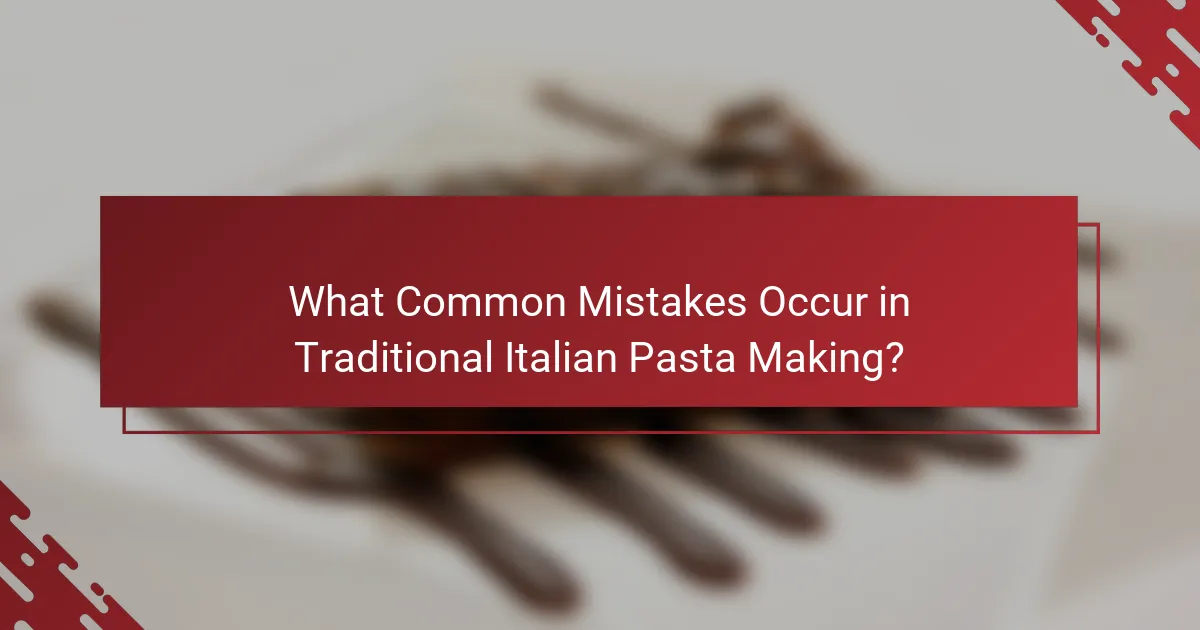Traditional Italian pasta making is a culinary process that involves creating pasta from basic ingredients such as flour, water, and eggs. This article delves into the historical significance of pasta in Italian culture, highlighting regional variations in shapes and recipes. It addresses common mistakes made during the pasta-making process, including the use of incorrect flour types and improper dough handling, while offering practical tips to enhance pasta quality. Key techniques discussed include the importance of using high-quality flour, adequate kneading, resting the dough, and proper cooking methods to achieve the ideal texture and flavor of authentic Italian pasta.

What is Traditional Italian Pasta Making?
Traditional Italian pasta making is a culinary process that involves the preparation of pasta from scratch using basic ingredients. This method typically utilizes flour, water, and sometimes eggs. The dough is kneaded until smooth and elastic, then rolled out and cut into various shapes.
Historically, this technique dates back to ancient times in Italy. Traditional pasta is often dried or cooked fresh, depending on the type. Each region in Italy has its own unique pasta shapes and recipes. The quality of ingredients significantly impacts the final product’s texture and flavor.
Proof of its significance is evident in Italian culture, where pasta is a staple food. According to the Italian National Institute of Statistics, Italians consume an average of 23.5 kilograms of pasta per person annually. This highlights the importance of pasta in daily life and culinary traditions.
How is Traditional Italian Pasta Made?
Traditional Italian pasta is made from a simple mixture of flour and water. The most common flour used is durum wheat semolina. The flour is combined with water to form a dough. This dough is kneaded until smooth and elastic. After kneading, it is allowed to rest for about 30 minutes. Resting helps to relax the gluten in the dough. Once rested, the dough is rolled out into thin sheets or shaped into various forms. Common shapes include fettuccine, tagliatelle, and ravioli. The pasta is then cooked in boiling salted water until al dente. Traditional techniques emphasize the importance of using high-quality ingredients and proper dough handling.
What ingredients are essential for making pasta?
The essential ingredients for making pasta are flour and water. Typically, durum wheat semolina flour is used for its high protein content. This type of flour provides the desired texture and firmness in the pasta. Water is combined with the flour to create a dough. Some recipes may also include eggs for added richness and flavor. The dough must be kneaded until smooth and elastic. This process helps develop gluten, which gives pasta its structure. The ratio of flour to water can vary based on the desired pasta type.
What are the different types of flour used in pasta making?
The different types of flour used in pasta making include durum wheat flour, all-purpose flour, and semolina flour. Durum wheat flour is high in protein and gluten, making it ideal for pasta. It provides a firm texture and is commonly used in traditional Italian pasta. All-purpose flour has a lower protein content and can be used for softer pasta varieties. Semolina flour, derived from durum wheat, has a coarse texture and is often used for making gnocchi and certain pasta shapes. Each type of flour contributes distinct qualities to the pasta, affecting its texture and cooking properties.
Why is Traditional Italian Pasta Making Important?
Traditional Italian pasta making is important because it preserves cultural heritage and culinary traditions. This process involves specific techniques passed down through generations. Authentic pasta making emphasizes quality ingredients, such as durum wheat and fresh eggs. It also fosters regional identity, as different areas have unique pasta shapes and recipes. The craftsmanship involved enhances the flavor and texture of the pasta. Traditional methods contribute to the overall dining experience by promoting authenticity. Moreover, pasta making supports local economies through the use of regional products. This culinary art form has been recognized by UNESCO as part of Italy’s intangible cultural heritage.
How does pasta making reflect Italian culture?
Pasta making reflects Italian culture through its emphasis on tradition, family, and regional diversity. The craft of making pasta is often passed down through generations. Families gather to prepare pasta, reinforcing bonds and cultural identity. Each region in Italy has its unique pasta shapes and recipes, showcasing local ingredients and culinary history. For example, orecchiette from Puglia and trofie from Liguria highlight regional specialties. This diversity illustrates the rich tapestry of Italian culinary heritage. Additionally, pasta is a staple in Italian cuisine, symbolizing comfort and togetherness in meals. The ritual of making pasta connects individuals to their roots and cultural narratives.
What are the historical origins of pasta making in Italy?
Pasta making in Italy has roots tracing back to ancient civilizations. The Etruscans and Romans consumed a form of pasta made from wheat. Historical texts, such as those by Apicius, mention dishes resembling pasta. By the Middle Ages, dried pasta became popular due to its long shelf life. The first documented mention of pasta in Italy dates to the 13th century. In the 14th century, pasta was commonly consumed in Southern Italy. The introduction of durum wheat in the 19th century improved pasta quality. Today, Italy is renowned for its diverse pasta varieties and regional specialties.
What Techniques are Used in Traditional Italian Pasta Making?
Traditional Italian pasta making employs techniques such as mixing, kneading, rolling, and cutting. Mixing involves combining flour and eggs to form a dough. Kneading develops gluten, giving the pasta its structure. Rolling the dough thinly is crucial for texture and cooking. Cutting shapes varies by pasta type, such as tagliatelle or ravioli. Drying is also a technique used for storage and preservation. Each technique contributes to the unique qualities of traditional Italian pasta.
How do you knead pasta dough effectively?
To knead pasta dough effectively, start by combining flour and eggs to form a rough dough. Use your hands to bring the ingredients together. Once combined, transfer the dough to a clean surface. Begin kneading by pressing the dough with the heel of your hand. Fold the dough over and repeat the process. Continue kneading for about 8 to 10 minutes. The dough should become smooth and elastic. Proper kneading develops gluten, which is crucial for pasta texture. A well-kneaded dough will spring back when pressed.
What rolling techniques are essential for pasta making?
Essential rolling techniques for pasta making include the use of a pasta machine and manual rolling. A pasta machine helps achieve uniform thickness and smooth texture. It typically has adjustable settings for different thickness levels. Manual rolling involves using a rolling pin to flatten the dough. This technique requires consistent pressure and even strokes. Both methods ensure the pasta can be cut into desired shapes. Properly rolled pasta cooks evenly and absorbs sauces better. Mastering these techniques is crucial for authentic Italian pasta.

What Common Mistakes Occur in Traditional Italian Pasta Making?
Common mistakes in traditional Italian pasta making include using the wrong flour type. Many use all-purpose flour instead of durum wheat flour, which is essential for authentic pasta. Another mistake is not allowing the dough to rest adequately. Resting helps gluten relax, leading to better texture. Overworking the dough also affects the final product. It can make the pasta tough instead of tender. Additionally, incorrect water-to-flour ratios can lead to either dry or overly sticky dough. Not salting the pasta water is another frequent error, as it enhances flavor. Lastly, cooking pasta for too long results in a mushy texture, deviating from the desired al dente finish.
What are the most frequent errors made by beginners?
Beginners often make several frequent errors in traditional Italian pasta making. One common mistake is using the wrong flour type. Many beginners choose all-purpose flour instead of the recommended ’00’ flour, which affects texture. Another error is improper hydration of the dough. Beginners may not add enough water, leading to dry pasta. Failing to knead the dough sufficiently is also typical. This results in less elastic pasta that does not hold shape well. Additionally, many overlook the importance of resting the dough. Skipping this step can lead to difficulties in rolling out the pasta. Overcooking pasta is another frequent issue. Beginners often do not test for doneness, resulting in mushy pasta. Finally, neglecting to salt the cooking water can lead to bland flavor. These errors hinder the quality of the final dish.
How can overworking the dough affect the final product?
Overworking the dough can lead to a tough and chewy final product. This occurs because excessive kneading develops gluten excessively. When gluten is overdeveloped, it creates a dense structure. This density can hinder the dough’s ability to stretch. As a result, the pasta may not cook evenly. It can also lose its desired tenderness. Ultimately, this affects the overall eating experience. Properly handled dough should yield a light and delicate texture.
What happens if the pasta is not cooked properly?
Undercooked pasta remains hard and chewy. This texture makes it unpleasant to eat. It can also lead to digestive discomfort. Overcooked pasta becomes mushy and loses its shape. This results in a less appealing dish. Proper cooking time is essential for optimal texture. According to the USDA, pasta should be cooked al dente for best results. Al dente pasta retains a firm bite and enhances the overall eating experience.
How Can You Avoid Mistakes in Pasta Making?
To avoid mistakes in pasta making, ensure precise measurement of ingredients. Use a kitchen scale for accurate flour and water ratios. Knead dough thoroughly for the right texture, which should be smooth and elastic. Allow the dough to rest for at least 30 minutes; this helps gluten development. Roll the dough evenly to achieve consistent thickness. When cutting pasta, use sharp tools for clean edges. Cook pasta in plenty of salted water to enhance flavor. Taste for doneness a minute before the package instructions suggest. Following these steps minimizes common errors and improves the final dish.
What tips can help you achieve the perfect pasta texture?
To achieve the perfect pasta texture, use the right flour type. Semolina flour is ideal for a firm texture. Ensure you measure ingredients accurately. A typical ratio is 1 cup of flour to 1 large egg. Knead the dough thoroughly for about 10 minutes. This develops gluten, enhancing elasticity. Rest the dough for at least 30 minutes. This allows the gluten to relax. Roll the dough evenly to your desired thickness. Thinner pasta cooks faster and has a delicate texture. Cook the pasta in boiling salted water. This enhances flavor and prevents stickiness. Test for doneness by tasting; it should be al dente. This means it is firm to the bite.
How can you ensure the right cooking time for different pasta types?
To ensure the right cooking time for different pasta types, refer to the package instructions. Each pasta type has a recommended cooking time based on its thickness and ingredients. For example, thin pasta like angel hair cooks in about 2-4 minutes, while thicker types like penne may take 11-13 minutes. Testing the pasta a minute or two before the suggested time is advisable. This technique, known as “al dente,” ensures the pasta retains a firm texture. Additionally, using a timer can help maintain accuracy. Consistent testing and following guidelines will yield optimal results.

What Tips Can Improve Your Traditional Italian Pasta Making Skills?
To improve your traditional Italian pasta making skills, focus on using high-quality flour. Tipo 00 flour is preferred for its fine texture and high protein content. Knead the dough thoroughly for about 10 minutes. This develops gluten, resulting in a better texture. Allow the dough to rest for at least 30 minutes. Resting helps relax the gluten, making it easier to roll out. Use a pasta machine for even thickness. Consistent thickness ensures even cooking. Cut the pasta shapes uniformly for uniform cooking times. Finally, cook pasta in plenty of salted water. This enhances the flavor and helps prevent sticking.
What best practices should you follow when making pasta?
Use high-quality flour for making pasta. Semolina flour or 00 flour are preferred for their gluten content. Measure ingredients accurately to ensure proper dough consistency. Mix flour and eggs in a clean surface or bowl, creating a well for the eggs. Knead the dough for about 10 minutes until smooth and elastic. Allow the dough to rest for at least 30 minutes before rolling it out. Roll the pasta thinly for even cooking and better texture. Cook pasta in a large pot of salted boiling water for optimal flavor. Test for doneness regularly to achieve al dente texture.
How do you store homemade pasta effectively?
To store homemade pasta effectively, first, ensure it is completely dry. Lay the pasta in a single layer on a floured surface or a clean kitchen towel. Allow it to air dry for at least 30 minutes. Once dried, you can store it in an airtight container. Alternatively, use resealable plastic bags for smaller portions. For long-term storage, freeze the pasta. Place it on a baking sheet in a single layer until frozen, then transfer to a freezer bag. Homemade pasta can last in the freezer for up to 8 months. Proper storage prevents spoilage and maintains texture.
What tools are essential for successful pasta making?
Essential tools for successful pasta making include a pasta machine, rolling pin, and a sharp knife. A pasta machine helps achieve consistent thickness in dough. A rolling pin is useful for flattening dough manually. A sharp knife is necessary for cutting pasta shapes accurately. Other helpful tools are a mixing bowl for combining ingredients and a clean surface for kneading. These tools enhance the efficiency and quality of homemade pasta.
What Resources are Available for Learning More About Pasta Making?
Books, online courses, and cooking classes are available for learning more about pasta making. Notable books include “Pasta Grannies: The Official Cookbook” by Vicky Bennison and “The Essentials of Italian Pasta” by Marcella Hazan. Online platforms like MasterClass offer courses taught by professional chefs, including pasta making techniques. Websites such as Serious Eats and The Kitchn provide detailed articles and recipes. Local culinary schools often offer hands-on pasta making classes. YouTube features numerous tutorial videos from experienced chefs and home cooks. These resources collectively cover various aspects of pasta making, from basic techniques to advanced recipes.
Where can you find authentic recipes for traditional Italian pasta?
Authentic recipes for traditional Italian pasta can be found in various reliable sources. Cookbooks by renowned Italian chefs often provide authentic recipes. Websites dedicated to Italian cuisine, such as GialloZafferano and Academia Barilla, offer traditional recipes. Additionally, culinary schools and workshops often share authentic recipes during classes. Online forums and communities focused on Italian cooking can also be valuable resources. Many of these platforms emphasize the use of traditional ingredients and techniques, ensuring authenticity.
What online courses or workshops are recommended for beginners?
Beginner-friendly online courses for traditional Italian pasta making include “Pasta Making from Scratch” on Udemy and “Mastering Pasta” on Coursera. These courses offer step-by-step instructions for various pasta types. They cover essential techniques and common mistakes to avoid. Each course provides video demonstrations and downloadable resources. Reviews indicate high satisfaction among learners. Many users report improved skills after completing these courses. These platforms are well-regarded for culinary education.
Traditional Italian pasta making is a culinary process that emphasizes the preparation of pasta from scratch using basic ingredients such as flour, water, and sometimes eggs. The article explores the historical origins, essential techniques, and various types of flour used in pasta making, highlighting the importance of quality ingredients and regional diversity. Common mistakes made by beginners, along with tips for achieving the perfect pasta texture, are also discussed. Additionally, the article provides resources for further learning and authentic recipes, emphasizing the cultural significance and craftsmanship involved in this traditional culinary art form.